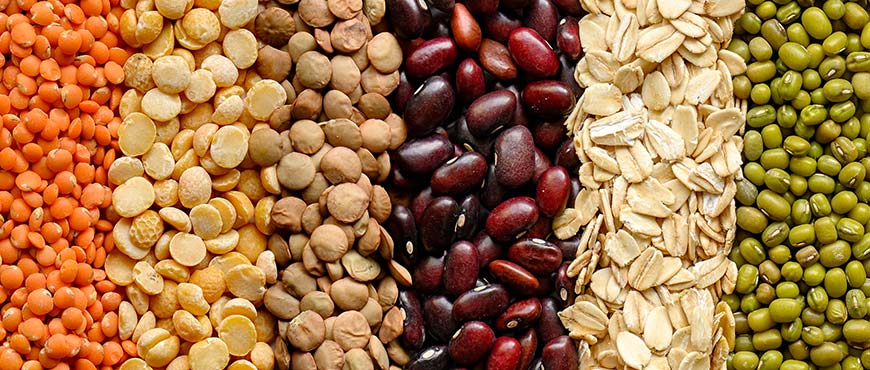A Comprehensive Guide: Lentils, Legumes, Beans, and Pulses
Choosing the right pulses isn’t that hard. This simple guide to different types of pulses will help you choose the best beans, lentils, and peas. Recipes around the world, especially vegetarian ones, are hard to imagine without some pulses used in them. Around the globe, dishes like soups, hummus, and burritos primarily use pulses, legumes, beans, and lentils as the main ingredients. So let’s understand the uses, differences, and tips for using different types of pulses with this article.
Different types of beans and pulses are a staple in Indian dishes, especially vegetarian ones. Although pulses, legumes, beans, and lentils are readily available in the local shops, they are inexpensive and make a substantial part of our diet, providing multiple nutritional benefits, mainly protein!
There are more than 20 varieties of pulses we can use in different recipes, and they are quite versatile in dietary properties. With your pantry full of pulses, you can easily prepare different starters, main courses, and desserts. Some of the popular recipes made with different types of pulses are Dal, Pakoras, Dosas, and sweets like Payasam (which contains a variety of pulses like moong dal). Not only Indian dishes but pulses are also useful in making delicacies like soups, burgers, vegan omelets, and stews.
What are the different types of pulses?
The story of pulses starts with the legume family. Leguminous plants grow in pods; their fruits or seeds are called legumes. Pulses are nothing but the dried versions of these edible seeds of leguminous plants. Some different types of pulses are black eyed peas, kala chana, malka masoor, moong split, moong whole, rajma Jammu, urad black split, and toor dal, amongst many others.
How to differentiate between lentils, legumes, beans, and pulses?
A pulse is an edible seed from a legume plant.
The main difference lies in their shapes! Lentils are shaped like a lens, and pulses are consumable seeds of legumes. Both pulses and lentils grow inside pods, have a high amount of proteins and fiber, and are low in fat.
The beans we consume are kidney-shaped; ideally, they need to be soaked before cooking, while lentils don’t. While lentils are flat in shape (toor dal), peas are round as they are fresh peeled from pods and then dried. Chickpeas have an angular shape, and dals are nothing but split versions of pulses.
While these differences are clear to our eyes, and we can identify them quickly, there are some similarities between lentils and pulses.
Those are:
- Both lentils and pulses belong to the legume family.
- Both grow inside pods.
- Both come in different sizes, shapes, and colors.
- Both need to be well-cooked before consuming.
- Both are rich in proteins and fiber.
Since we have understood the differences and similarities between lentils, legumes, beans, and pulses, let’s know more about their importance in our diet.
How are pulses important in our diet?
Legumes, lentils, pulses, and beans are rich in:
- Protein
- Folate
- Fiber
- Iron
- Phosphorus
- Good fatty acids like linoleic and oleic acids
The legume family makes a significant part of our balanced diet and helps us manage various chronic diseases like:
- Cardiovascular diseases: Fiber, folates, and phytochemicals in different types of legumes benefit heart health. The fibers may help lower blood cholesterol levels without affecting the body weight and prevent blood sugar which is a significant risk to cardiovascular health.
- Digestive health: Due to their high fiber content and non-digestible carbs, legumes help in digestion.
- Diabetes: Due to their low glycemic index, legumes, pulses, and beans are highly recommended for people with diabetes. Some more reasons they might be good for preventing diabetes are slow-digesting resistant starch.
- Obesity: Legumes may also help control body weight by significantly supporting weight loss. The protein and fiber content (both soluble and insoluble) may give feelings of fullness and reduce total calorie intake.
Along with keeping us away from these diseases, legumes, beans, lentils, and pulses also help maintain overall health. Here is an interesting read about The Secret to Better Health, Skin, and Hair.
Examples of commonly-used pulses in Indian food
Indian food is prepared using varieties of lentils, pulses, and beans. Here is a list we compiled for you to get started with their use in your diet:
- Moong dal – Green beans / green lentils
- Chawli / Lobia – Black-eyed beans
- Masoor dal – Red lentil dal
- Toor / toovar dal – Yellow pigeon peas
- Matki – Turkish / dew gram beans
- Rajma – Red kidney beans
- Vatana – White and green peas
- Chana dal – Split Bengal gram
- Urad dal – Black gram beans, split black gram, and split and skinned black gram.
Read our article on 5 Types of Pulses You Must Include In Your Diet.
How to store pulses?
Even if we think pulses, beans, and legumes can stay fresh for longer in our kitchens, they are prone to get infected with bugs and other bacteria if not taken good care of.
Here are some easy tips for storing pulses if you are not familiar with the traditional concepts, which make them last for weeks or even months.
- Aeration – Keeping pulses in sunlight for a day or two and then airing them helps maintain good quality and reduces pest problems.
- Roasting – If you are storing them in a jar, roasting some pulses can be a good idea; you can also add a pinch of dry red chili to the jar while storing.
- Refrigeration – Not so traditional, but a useful method. Just store dry pulses in jars and keep them in the fridge. Pulses won’t spoil for a long time, and cooler temperatures will keep the insects away.
If you have a good stock of pulses and beans at home, you can survive longer if you are not willing to leave home for days. This is because pulses are rich in dietary nutrients and make our meals complete.
How to cook pulses and dals?
Cooking pulses, dals, and other legumes is easy.
- Cooking with regular pots: Dried beans, lentils, and peas are dry, so you need to soak them overnight and cook for 30 to 90 minutes. Whole lentils take 30 minutes, and whole peas take 90 minutes to cook in regular pots.
- Cooking with a pressure cooker or instant pots: Pressure cookers speed up your cooking process. Soaking your legumes, beans, and pulses before cooking them in pressure cooking will make their texture creamier and make them easier to digest.
Here, you can explore Delicious Dishes Made From Organic Pulses.
Now that you know how the legume family, i.e., pulses, beans, and lentils, are among the most nutritious and economical foods. You need to make sure you buy fresh produce, especially organic ones, and know the trusted place to buy them.
Dwaraka Organic is one of the trusted places to buy organic pulses in the USA. Why? Our products are pure and unadulterated. Yes, you get the best fresh produce at Dwaraka Organic. So, explore our variety of organic foods and ingredients to make your diet healthy, organic, and natural!



